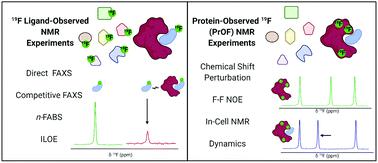当前位置:
X-MOL 学术
›
RSC Chem. Biol.
›
论文详情
Our official English website, www.x-mol.net, welcomes your
feedback! (Note: you will need to create a separate account there.)
19 F NMR viewed through two different lenses: ligand-observed and protein-observed 19F NMR applications for fragment-based drug discovery
RSC Chemical Biology ( IF 4.2 ) Pub Date : 2021-07-12 , DOI: 10.1039/d1cb00085c Caroline R Buchholz 1 , William C K Pomerantz 1, 2
RSC Chemical Biology ( IF 4.2 ) Pub Date : 2021-07-12 , DOI: 10.1039/d1cb00085c Caroline R Buchholz 1 , William C K Pomerantz 1, 2
Affiliation

|
19
F NMR has emerged as a powerful tool in drug discovery, particularly in fragment-based screens. The favorable magnetic resonance properties of the fluorine-19 nucleus, the general absence of fluorine in biological settings, and its ready incorporation into both small molecules and biopolymers, has enabled multiple applications of 19F NMR using labeled small molecules and proteins in biophysical, biochemical, and cellular experiments. This review will cover developments in ligand-observed and protein-observed 19F NMR experiments tailored towards drug discovery with a focus on fragment screening. We also cover the key advances that have furthered the field in recent years, including quantitative, structural, and in-cell methodologies. Several case studies are described for each application to highlight areas for innovation and to further catalyze new NMR developments for using this versatile nucleus.
中文翻译:

通过两种不同的视角观察 19 F NMR:配体观察和蛋白质观察 19F NMR 在基于片段的药物发现中的应用
19 F NMR 已成为药物发现的强大工具,特别是在基于片段的筛选中。氟 19 核的有利磁共振特性、生物环境中普遍不存在氟以及其易于掺入小分子和生物聚合物中,使得 19 F NMR 使用标记的小分子和蛋白质在生物物理、生物化学中得到多种应用。和细胞实验。本综述将涵盖针对药物发现而定制的配体观察和蛋白质观察19 F NMR 实验的进展,重点是片段筛选。我们还介绍了近年来推动该领域发展的关键进展,包括定量、结构和细胞内方法。针对每种应用描述了几个案例研究,以突出创新领域并进一步促进使用这种多功能核的新 NMR 开发。
更新日期:2021-07-16
中文翻译:

通过两种不同的视角观察 19 F NMR:配体观察和蛋白质观察 19F NMR 在基于片段的药物发现中的应用
19 F NMR 已成为药物发现的强大工具,特别是在基于片段的筛选中。氟 19 核的有利磁共振特性、生物环境中普遍不存在氟以及其易于掺入小分子和生物聚合物中,使得 19 F NMR 使用标记的小分子和蛋白质在生物物理、生物化学中得到多种应用。和细胞实验。本综述将涵盖针对药物发现而定制的配体观察和蛋白质观察19 F NMR 实验的进展,重点是片段筛选。我们还介绍了近年来推动该领域发展的关键进展,包括定量、结构和细胞内方法。针对每种应用描述了几个案例研究,以突出创新领域并进一步促进使用这种多功能核的新 NMR 开发。











































 京公网安备 11010802027423号
京公网安备 11010802027423号